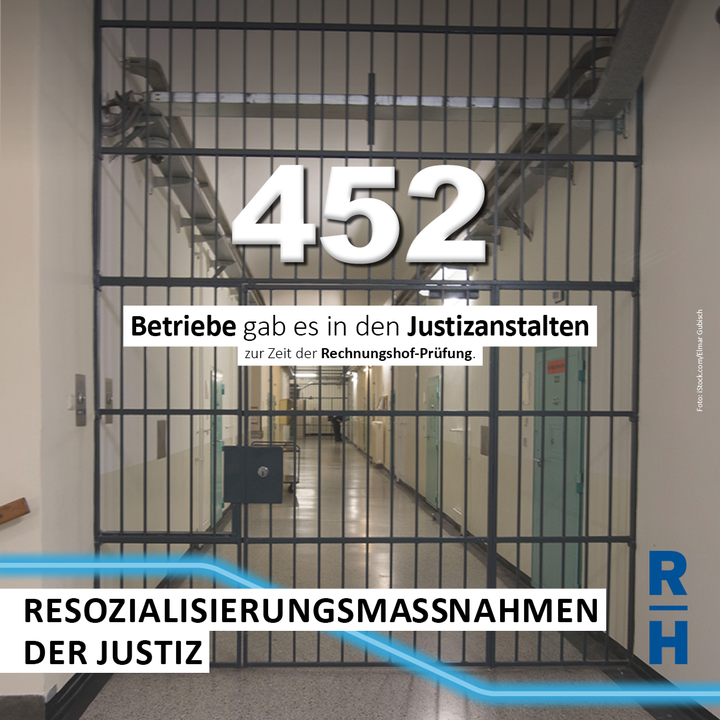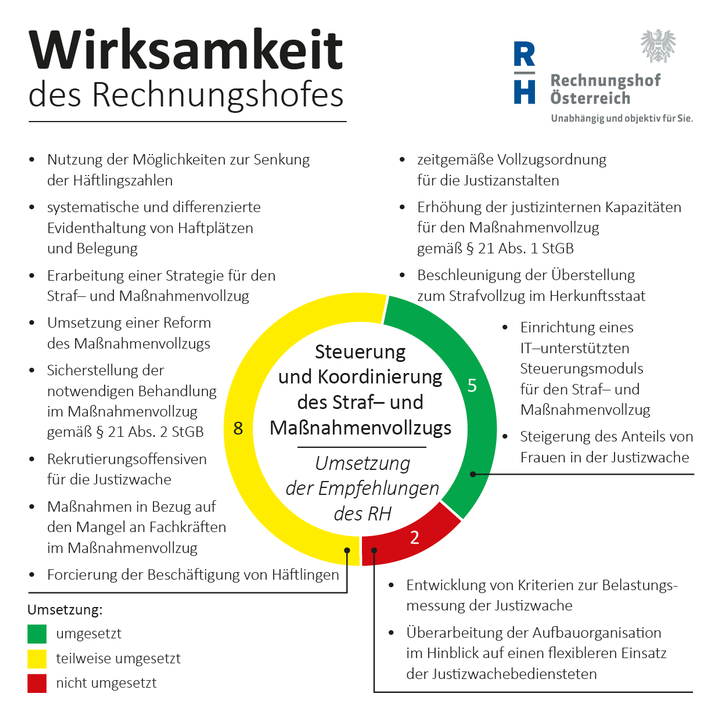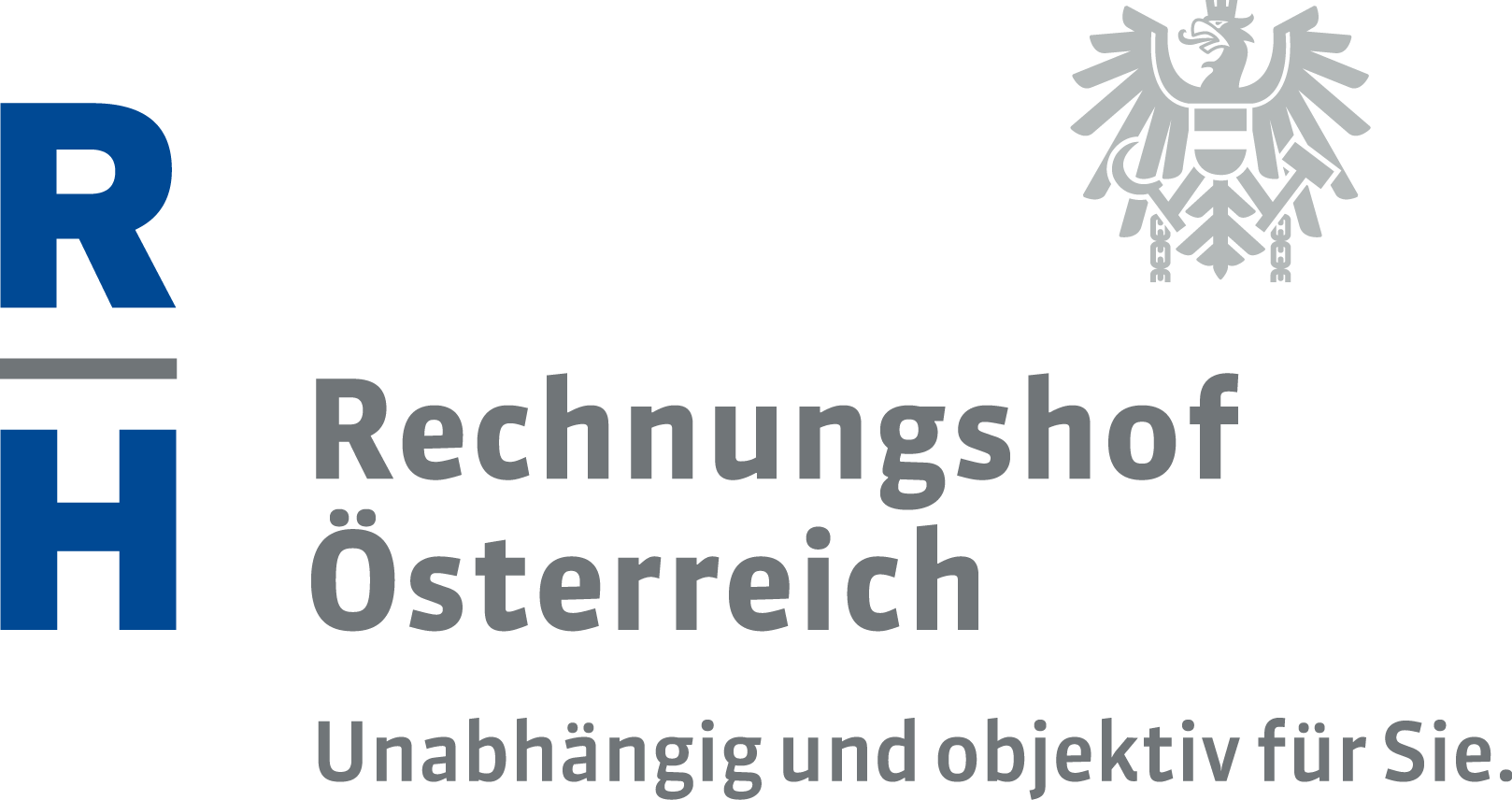Correctional facilities at the limits: Increase work opportunities to improve reintegration

Correctional facilities have been working at the limits of their capacity for years, they are overcrowded and largely affected by staff shortage. This is what the ACA observed in its reports “Management and Coordination of the Execution of Sentences and Measures – Follow-Up Audit” („Steuerung und Koordinierung des Straf- und Maßnahmenvollzugs; Follow-up-Überprüfung“) and “Judicial Resocialisation Measures” („Resozialisierungsmaßnahmen der Justiz“) published today. The challenging staff situation has directly affected reintegration efforts: It impeded a lasting increase of prison work, workshops were often subject to closures, and only limited activities were available in the afternoon and on weekends. Notably, inmates of court prisons were locked up in their cells for up to 23 hours per day. The ACA’s auditors recommend that correctional facilities invest more in personnel development in order to fulfil their legal mandate to reintegrate prisoners. Moreover, it recommends improving operational structures, adapting work and training opportunities to the needs, and investing in construction measures. The audit covered the periods from 2019 to 2022 and from 2018 to 2022, respectively.
The strategic and operational management of correctional facilities and involuntary forensic placement lies in the responsibility of the General Directorate for the Administration of Custodial Sanctions and Measures Involving Deprivation of Liberty, a section of the Ministry of Justice. On 1 March 2023, a total of 9,127 prisoners were held in the 28 correctional facilities. Federal payments for the prison system amounted to EUR 599.79 billion in 2022.
Staffing situation creates need for action

The follow-up audit “Management and Coordination of the Execution of Sentences and Measures” found that of the 15 assessed recommendations, the Ministry of Justice had implemented five fully, eight in part and two not at all.
As compared to 2019, the situation in the correctional institutions had aggravated further due to a general decline of prison spaces. Possibilities for reducing the prison population – e.g., by electronically monitored home detention or by transferring prisoners to their states of origin – were limited for legal and factual reasons. The Ministry of Justice has been working on an amendment of the Correctional Service Act with a focus on reintegration measures, which is also aimed at reducing the prison population. Without relief measures, however, overcrowding can only be remedied by increasing prison capacities.
Further tightening of the staff situation can be expected. While 96 percent of all posts were occupied in the beginning of 2023, more than 130 full-time posts were still vacant. At the same time, applications decreased by more than a quarter between 2019 and 2022.
Reform of involuntary forensic placement: Open points
A part of the planned reform of involuntary forensic placement was implemented with the Amendment Act on Measures Involving Deprivation of Liberty 2022 (Maßnahmenvollzugsanpassungsgesetz 2022). However, no measures have yet been taken to ensure that forensic patients are treated and cared for in an adequate and modern way.
Considerable differences in employment rates
In the report “Judicial Reintegration Measures” („Resozialisierungsmaßnahmen der Justiz“), the ACA’s auditors consider that sufficient employment and training activities are crucial for structuring the prisoners’ daily routine, creating a positive atmosphere and reintegrating prisoners into society. In view thereof, the auditors critically note that the employment rate differs considerably between the correctional facilities. For example, 69 percent of the prisoners in Wien-Simmering were employed in 2023, as opposed to 94 percent in the Prison for Juveniles Gerasdorf. The average duration of employment could not be sustainably increased during the audited period. In average, prisoners worked for 3,16 hours per working day in 2022. The ACA recommends working towards increasing the employment rate.
At the time of the audit, there was a total of 452 operational units and workshops – such as metalworking shops and joineries – across all correctional institutions. While some of them provide maintenance services for the prisons (e.g., kitchens, bakeries or laundry facilities), the so-called outsourcing units generally carry out simple tasks for outside companies. A holistic approach to the operational structure is lacking, and temporary closures occurred frequently. The ACA opines that such closures can negatively impact the motivation of both the prison guards and the prisoners. It recommends evaluating and, where appropriate, optimising the operational structure under a holistic approach.
Furthermore, the ACA critically notes that only limited activities were available for prisoners in the afternoon and on weekends – which, in the ACA’s opinion, prevents reintegration. According to the correctional facilities, appropriate activities for prisoners are mainly impeded by the lack of personnel.
Adjustment of training and further education for prisoners
The ACA views positively that the correctional facilities offer training and further education for prisoners. Such qualification measures are essential for increasing chances of reintegration and finding work. However, the prison population has changed over time and basic qualifications, such as sufficient German skills, are often lacking. Since the mid-2010s, the proportion of non-Austrian citizens lies around or slightly above 50 percent. In the ACA’s opinion, it is necessary to adapt training and further education opportunities to the needs. At present, there is only limited scope for the vocational training meant to provide a sustainable qualification of prisoners. For example, not all places for intensive training at the Prison Wien-Simmering could be filled due to a lack of suitable trainees.
Qualitative studies required to assess effectiveness of the penal system
The ACA views positively that the Ministry of Justice has set an independent impact target regarding the penal system, which places a special focus on reintegration and prevention of recidivism. However, it critically notes that the indicators are solely input-oriented; there is no indicator measuring the effectiveness of reintegration measures with regards to recidivism. The General Directorate intends to implement the recidivism rate – the proportion of persons who return to prison or involuntary forensic placement within four years from their release – as a new indicator. In 2021, the recidivism rate was 21 percent.For a qualitative impact assessment (in-depth studies on the effectiveness of the penal system or of specific reintegration and resocialization measures, as well as on the life situation of former prisoners), the Ministry of Justice should turn to scientific institutions, in particular from the university sector
- pdf Datei:
- 3,394.5 KB
- Umfang:
- 104 Seiten
Report: Judicial Resocialisation Measures (in German)
- pdf Datei:
- 2,204.4 KB
- Umfang:
- 72 Seiten


